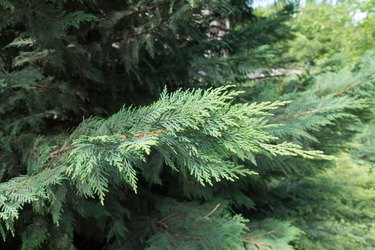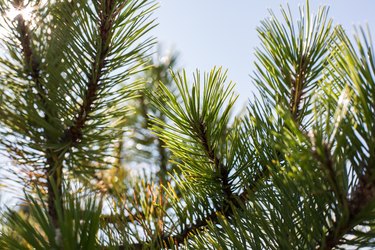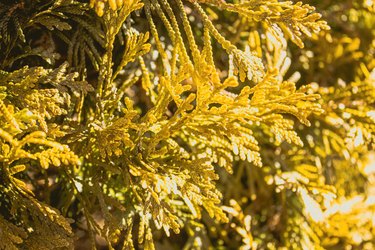There can be many culprits if a pine tree is turning yellow, but sometimes, the cause is natural and nothing to worry about. Even though pine trees (Pinus spp.) are evergreen coniferous trees, they still drop needles regularly as the needles get older. Watering issues, damage and pests can also cause pine trees to turn yellow. Examining the location and type of needle yellowing helps you determine the cause and find a solution.
If you’ve noticed the needles on your Austrian pine trees turning yellow, it can be alarming. These iconic evergreen conifers are supposed to stay green year-round, so yellowing foliage is a sign that something is wrong. In this article we’ll explore the common reasons behind yellowing leaves on Austrian pines and what you can do about it.
What Causes Austrian Pine Needles to Turn Yellow?
There are a few key factors that can cause the needles on Austrian pine trees to turn yellow or brown
-
Environmental Stress – Extreme weather, improper soil conditions, and drought can all put stress on Austrian pines. This stress impairs the tree’s ability to photosynthesize and causes the needles to discolor and drop.
-
Diseases – Fungal diseases like diplodia tip blight, dothistroma needle blight, and brown spot needle blight can infect Austrian pines. These diseases cause yellowing, browning, and dropping of needles.
-
Pests – Insects like pine needle scale, sawflies, and bark beetles feed on pine trees, leading to yellowing and loss of needles.
-
Poor Nutrient Uptake – Issues with the roots from things like girdling, improper planting depth, or compacted soil can prevent the tree from taking up nutrients properly This leads to overall yellowing of the needles
-
Sunscald – Damage from winter sun and wind exposure can cause yellowing damage, primarily on the most exposed side of the tree.
How to Identify the Cause
Pinpointing the specific cause of yellowing pine needles can be tricky. Here are some tips for identifying potential issues:
-
Examine the needles and tree closely. Look for signs of fungal growth, insects, abnormal needle patterns, and resin bleeding on the bark.
-
Consider the tree’s location and exposure to wind or harsh sunlight. Sunscald damage is often only on one side.
-
Inspect the soil and roots around the tree. Signs like compacted soil, girdling roots, or improper planting depth may point to root-related issues.
-
Review recent weather events like drought or extreme cold. Environmental stress often causes yellowing.
-
Have a sample of the yellowing needles analyzed by a lab to test for disease or nutrient deficiencies.
What to Do About Yellowing Austrian Pine Needles
Once you identify the likely cause of the yellowing needles, here are some tips to get your pine tree back to health:
-
Improve soil conditions – Amend soil with compost, aerate compacted areas, and mulch to retain moisture. Proper soil is key to reducing stress.
-
Adjust watering – Increase water for drought-stressed trees, but allow soil to dry between waterings. Reduce water for oversaturated soil.
-
Treat disease – Remove infected branches, disinfect tools between cuts, and apply fungicides at the first sign of disease.
-
Control pests – Apply horticultural oils and insecticidal soaps to suffocate and deter pests. Seek professional help for large infestations.
-
Fertilize – Use a balanced tree fertilizer to provide missing nutrients associated with yellowing.
-
Prune affected areas – Strategically remove branches or needle sections that are yellowed or dead.
-
Protect from winter damage – Wrap trunks, provide windbreaks, and paint trunks white to prevent winter sunscald.
When to Call a Professional
If your Austrian pine’s yellowing needles do not improve with treatment or the tree seems to be in serious decline, contact a certified arborist. They can help diagnose issues through testing and analysis and provide treatment plans for diseases, pests, and high levels of tree stress. Saving a valuable mature pine is well worth the investment.
With some detective work and prompt care, you can get your Austrian pine’s beautiful green color back. But at the first signs of trouble, take action to determine the cause and implement solutions. Catching issues early maximizes your chances of restoring the pine’s health. Don’t let your Austrian pine remain yellow for long without taking steps to identify and correct the problem.

Normal Seasonal Needle Loss
Video of the Day
Older pine needles on the interior of many types of pine trees turn yellow naturally. They typically then turn reddish-brown and eventually fall off the tree. This cause of pine trees turning yellow typically happens in the fall. If you think the needles are turning yellow due to natural aging, you dont need to do anything for your tree.



Video of the Day
Pine trees appreciate a good drink, especially during periods of drought, but too much water can cause yellowing needles. When you overwater your pine, the roots cant get the oxygen they need. If youre overwatering, youll likely see yellow needles and droopiness.
Hold off on watering if you think this is the issue. You can use a soil moisture meter to check the soil around the tree or insert your finger into the soil to see if it feels saturated to a few inches deep. Let the soil dry out slightly before watering again.
In the winter, your pine trees are susceptible to sun scald due to the environmental conditions. The combination of dry air, winter winds and low soil moisture can make the tree more susceptible to intense winter sun. Youll likely only see the yellowing on one side of the tree where its most exposed to the winter winds. The yellowing mainly affects the tips of the tree branches with the interior needles staying sheltered.



Sun scald usually corrects itself in time, but the yellowing will likely last until the next season. You can cut down on the risk of sun scald by watering your pine tree once or twice per month when the temperature remains above 40 degrees Fahrenheit.
Pine Tree Freeze Damage
Another winter threat for pine trees that can cause yellowing is freeze damage. This most often happens when theres a sudden temperature drop causing a sudden hard freeze when temperatures were previously warm. The major temperature swing doesnt give the pine tree enough time to go through its natural metabolic processes that protect it from the cold. Freeze damage typically causes yellowing just at the tips on all sides of the tree.
Since you cant control the weather, theres usually not much you can do to prevent freeze damage. Your pine tree will often return to a healthy state on its own. You might need to grab pruning tools and remove damaged parts of the pine tree in the spring.
Pine wilt disease, caused by the pine wood nematode, can cause the pine needles to change to an off-green or yellowish color. Once the needles die, they hang onto the tree for a long time. Scotch pines (Pinus sylvestris, USDA zones 2-) are particularly susceptible to this condition.
Once infected, the pine tree will die, often within months. If your pine tree is large, it could hang on for a year or two. Theres no way to cure the disease, but removing and disposing of a pine tree infected with pine wilt can prevent it from spreading to other pines.
Why are the pine needles turning yellow?
FAQ
Why is my Austrian pine turning yellow?
How often should I water my Austrian pine?
Is a pine tree dead if it turns yellow?
How do you save yellowing pine?
Why are my pine needles turning yellow?
If you think the needles are turning yellow due to natural aging, you don’t need to do anything for your tree. Pine trees appreciate a good drink, especially during periods of drought, but too much water can cause yellowing needles. When you overwater your pine, the roots can’t get the oxygen they need.
What are the symptoms of a yellowing pine tree?
The symptoms of a yellowing pine tree will vary depending on the cause. However, some of the most common symptoms include: Needle discoloration. The needles of a yellowing pine tree will often turn yellow, brown, or orange. Needle loss. A yellowing pine tree may also lose its needles.
How do you know if a pine tree is yellow?
The needles of a yellowing pine tree will often turn yellow, brown, or orange. Needle loss. A yellowing pine tree may also lose its needles. This can be a gradual process, or the tree may suddenly lose all of its needles. Wilting or drooping branches. The branches of a yellowing pine tree may wilt or droop.
Do Austrian pine trees have blight?
Austrian pine trees are relatively resistant to pests and diseases but may occasionally encounter issues such as bark beetles, pine needle scale, or diplodia tip blight. Inspect your tree regularly for signs of pest infestation or disease symptoms, such as yellowing needles, oozing sap, or stunted growth.
